Introduction to Marketing Assignment (Solution)
VerifiedAdded on 2021/06/30
|13
|3820
|81
AI Summary
Contribute Materials
Your contribution can guide someone’s learning journey. Share your
documents today.
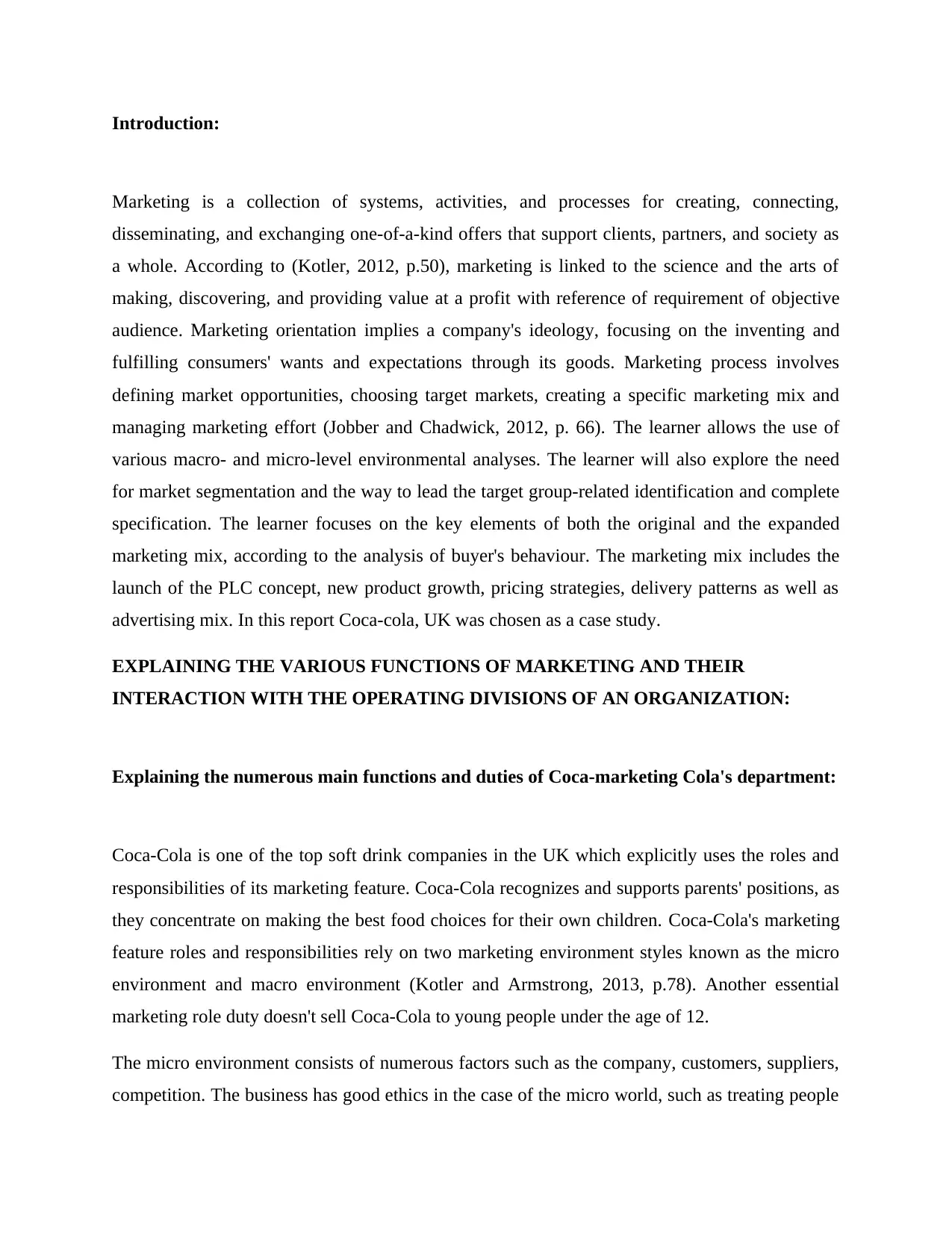
Introduction:
Marketing is a collection of systems, activities, and processes for creating, connecting,
disseminating, and exchanging one-of-a-kind offers that support clients, partners, and society as
a whole. According to (Kotler, 2012, p.50), marketing is linked to the science and the arts of
making, discovering, and providing value at a profit with reference of requirement of objective
audience. Marketing orientation implies a company's ideology, focusing on the inventing and
fulfilling consumers' wants and expectations through its goods. Marketing process involves
defining market opportunities, choosing target markets, creating a specific marketing mix and
managing marketing effort (Jobber and Chadwick, 2012, p. 66). The learner allows the use of
various macro- and micro-level environmental analyses. The learner will also explore the need
for market segmentation and the way to lead the target group-related identification and complete
specification. The learner focuses on the key elements of both the original and the expanded
marketing mix, according to the analysis of buyer's behaviour. The marketing mix includes the
launch of the PLC concept, new product growth, pricing strategies, delivery patterns as well as
advertising mix. In this report Coca-cola, UK was chosen as a case study.
EXPLAINING THE VARIOUS FUNCTIONS OF MARKETING AND THEIR
INTERACTION WITH THE OPERATING DIVISIONS OF AN ORGANIZATION:
Explaining the numerous main functions and duties of Coca-marketing Cola's department:
Coca-Cola is one of the top soft drink companies in the UK which explicitly uses the roles and
responsibilities of its marketing feature. Coca-Cola recognizes and supports parents' positions, as
they concentrate on making the best food choices for their own children. Coca-Cola's marketing
feature roles and responsibilities rely on two marketing environment styles known as the micro
environment and macro environment (Kotler and Armstrong, 2013, p.78). Another essential
marketing role duty doesn't sell Coca-Cola to young people under the age of 12.
The micro environment consists of numerous factors such as the company, customers, suppliers,
competition. The business has good ethics in the case of the micro world, such as treating people
Marketing is a collection of systems, activities, and processes for creating, connecting,
disseminating, and exchanging one-of-a-kind offers that support clients, partners, and society as
a whole. According to (Kotler, 2012, p.50), marketing is linked to the science and the arts of
making, discovering, and providing value at a profit with reference of requirement of objective
audience. Marketing orientation implies a company's ideology, focusing on the inventing and
fulfilling consumers' wants and expectations through its goods. Marketing process involves
defining market opportunities, choosing target markets, creating a specific marketing mix and
managing marketing effort (Jobber and Chadwick, 2012, p. 66). The learner allows the use of
various macro- and micro-level environmental analyses. The learner will also explore the need
for market segmentation and the way to lead the target group-related identification and complete
specification. The learner focuses on the key elements of both the original and the expanded
marketing mix, according to the analysis of buyer's behaviour. The marketing mix includes the
launch of the PLC concept, new product growth, pricing strategies, delivery patterns as well as
advertising mix. In this report Coca-cola, UK was chosen as a case study.
EXPLAINING THE VARIOUS FUNCTIONS OF MARKETING AND THEIR
INTERACTION WITH THE OPERATING DIVISIONS OF AN ORGANIZATION:
Explaining the numerous main functions and duties of Coca-marketing Cola's department:
Coca-Cola is one of the top soft drink companies in the UK which explicitly uses the roles and
responsibilities of its marketing feature. Coca-Cola recognizes and supports parents' positions, as
they concentrate on making the best food choices for their own children. Coca-Cola's marketing
feature roles and responsibilities rely on two marketing environment styles known as the micro
environment and macro environment (Kotler and Armstrong, 2013, p.78). Another essential
marketing role duty doesn't sell Coca-Cola to young people under the age of 12.
The micro environment consists of numerous factors such as the company, customers, suppliers,
competition. The business has good ethics in the case of the micro world, such as treating people
Secure Best Marks with AI Grader
Need help grading? Try our AI Grader for instant feedback on your assignments.
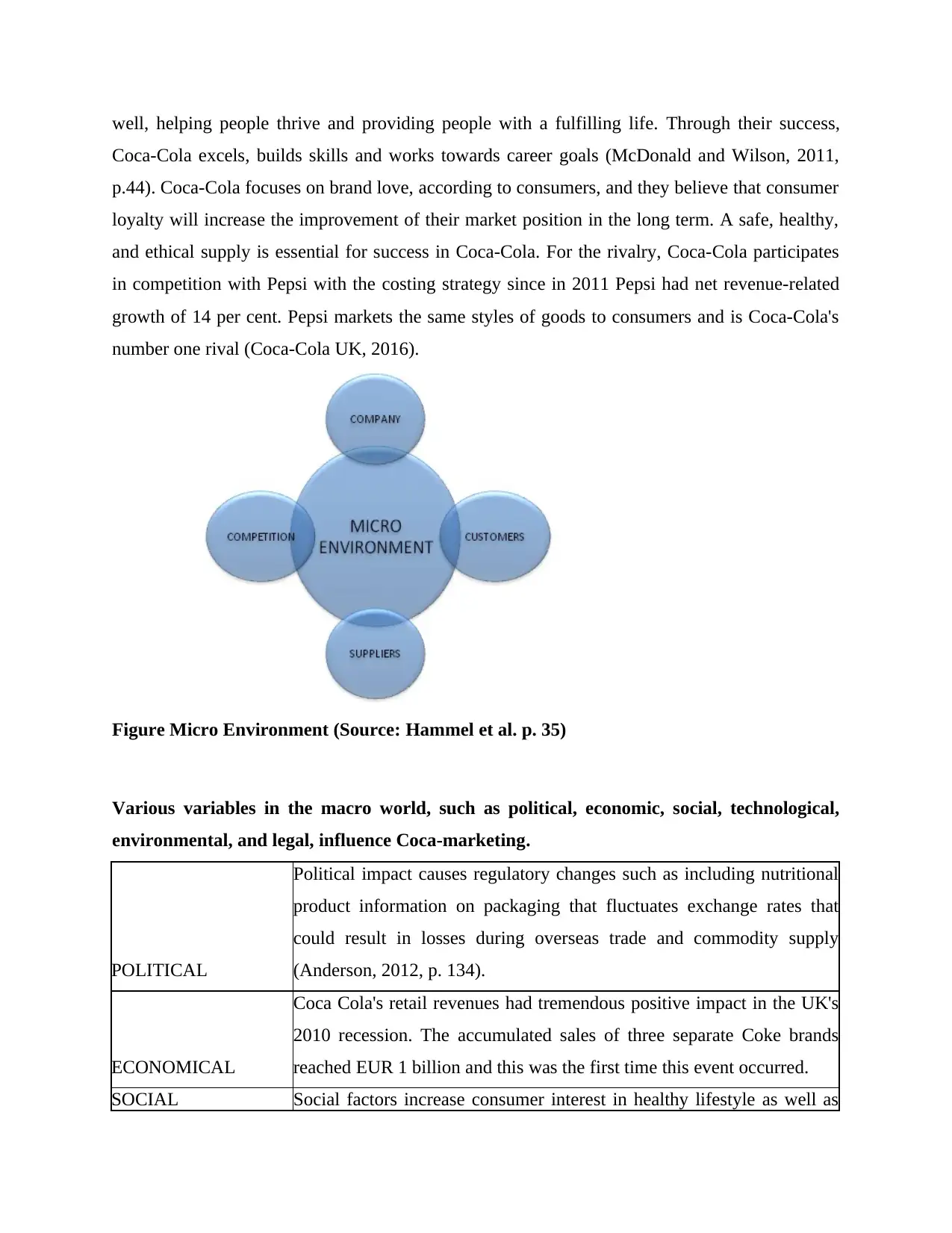
well, helping people thrive and providing people with a fulfilling life. Through their success,
Coca-Cola excels, builds skills and works towards career goals (McDonald and Wilson, 2011,
p.44). Coca-Cola focuses on brand love, according to consumers, and they believe that consumer
loyalty will increase the improvement of their market position in the long term. A safe, healthy,
and ethical supply is essential for success in Coca-Cola. For the rivalry, Coca-Cola participates
in competition with Pepsi with the costing strategy since in 2011 Pepsi had net revenue-related
growth of 14 per cent. Pepsi markets the same styles of goods to consumers and is Coca-Cola's
number one rival (Coca-Cola UK, 2016).
Figure Micro Environment (Source: Hammel et al. p. 35)
Various variables in the macro world, such as political, economic, social, technological,
environmental, and legal, influence Coca-marketing.
POLITICAL
Political impact causes regulatory changes such as including nutritional
product information on packaging that fluctuates exchange rates that
could result in losses during overseas trade and commodity supply
(Anderson, 2012, p. 134).
ECONOMICAL
Coca Cola's retail revenues had tremendous positive impact in the UK's
2010 recession. The accumulated sales of three separate Coke brands
reached EUR 1 billion and this was the first time this event occurred.
SOCIAL Social factors increase consumer interest in healthy lifestyle as well as
Coca-Cola excels, builds skills and works towards career goals (McDonald and Wilson, 2011,
p.44). Coca-Cola focuses on brand love, according to consumers, and they believe that consumer
loyalty will increase the improvement of their market position in the long term. A safe, healthy,
and ethical supply is essential for success in Coca-Cola. For the rivalry, Coca-Cola participates
in competition with Pepsi with the costing strategy since in 2011 Pepsi had net revenue-related
growth of 14 per cent. Pepsi markets the same styles of goods to consumers and is Coca-Cola's
number one rival (Coca-Cola UK, 2016).
Figure Micro Environment (Source: Hammel et al. p. 35)
Various variables in the macro world, such as political, economic, social, technological,
environmental, and legal, influence Coca-marketing.
POLITICAL
Political impact causes regulatory changes such as including nutritional
product information on packaging that fluctuates exchange rates that
could result in losses during overseas trade and commodity supply
(Anderson, 2012, p. 134).
ECONOMICAL
Coca Cola's retail revenues had tremendous positive impact in the UK's
2010 recession. The accumulated sales of three separate Coke brands
reached EUR 1 billion and this was the first time this event occurred.
SOCIAL Social factors increase consumer interest in healthy lifestyle as well as
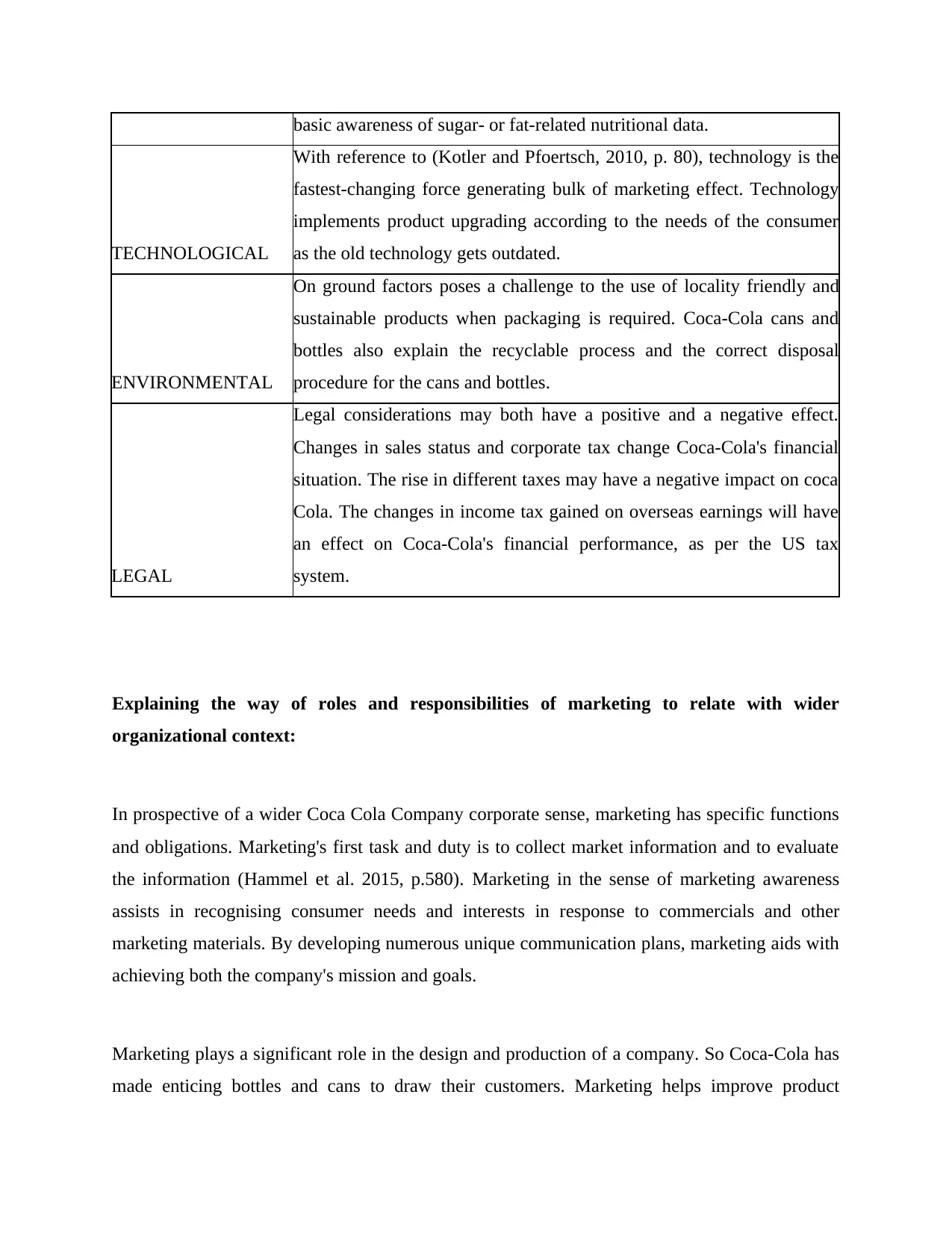
basic awareness of sugar- or fat-related nutritional data.
TECHNOLOGICAL
With reference to (Kotler and Pfoertsch, 2010, p. 80), technology is the
fastest-changing force generating bulk of marketing effect. Technology
implements product upgrading according to the needs of the consumer
as the old technology gets outdated.
ENVIRONMENTAL
On ground factors poses a challenge to the use of locality friendly and
sustainable products when packaging is required. Coca-Cola cans and
bottles also explain the recyclable process and the correct disposal
procedure for the cans and bottles.
LEGAL
Legal considerations may both have a positive and a negative effect.
Changes in sales status and corporate tax change Coca-Cola's financial
situation. The rise in different taxes may have a negative impact on coca
Cola. The changes in income tax gained on overseas earnings will have
an effect on Coca-Cola's financial performance, as per the US tax
system.
Explaining the way of roles and responsibilities of marketing to relate with wider
organizational context:
In prospective of a wider Coca Cola Company corporate sense, marketing has specific functions
and obligations. Marketing's first task and duty is to collect market information and to evaluate
the information (Hammel et al. 2015, p.580). Marketing in the sense of marketing awareness
assists in recognising consumer needs and interests in response to commercials and other
marketing materials. By developing numerous unique communication plans, marketing aids with
achieving both the company's mission and goals.
Marketing plays a significant role in the design and production of a company. So Coca-Cola has
made enticing bottles and cans to draw their customers. Marketing helps improve product
TECHNOLOGICAL
With reference to (Kotler and Pfoertsch, 2010, p. 80), technology is the
fastest-changing force generating bulk of marketing effect. Technology
implements product upgrading according to the needs of the consumer
as the old technology gets outdated.
ENVIRONMENTAL
On ground factors poses a challenge to the use of locality friendly and
sustainable products when packaging is required. Coca-Cola cans and
bottles also explain the recyclable process and the correct disposal
procedure for the cans and bottles.
LEGAL
Legal considerations may both have a positive and a negative effect.
Changes in sales status and corporate tax change Coca-Cola's financial
situation. The rise in different taxes may have a negative impact on coca
Cola. The changes in income tax gained on overseas earnings will have
an effect on Coca-Cola's financial performance, as per the US tax
system.
Explaining the way of roles and responsibilities of marketing to relate with wider
organizational context:
In prospective of a wider Coca Cola Company corporate sense, marketing has specific functions
and obligations. Marketing's first task and duty is to collect market information and to evaluate
the information (Hammel et al. 2015, p.580). Marketing in the sense of marketing awareness
assists in recognising consumer needs and interests in response to commercials and other
marketing materials. By developing numerous unique communication plans, marketing aids with
achieving both the company's mission and goals.
Marketing plays a significant role in the design and production of a company. So Coca-Cola has
made enticing bottles and cans to draw their customers. Marketing helps improve product
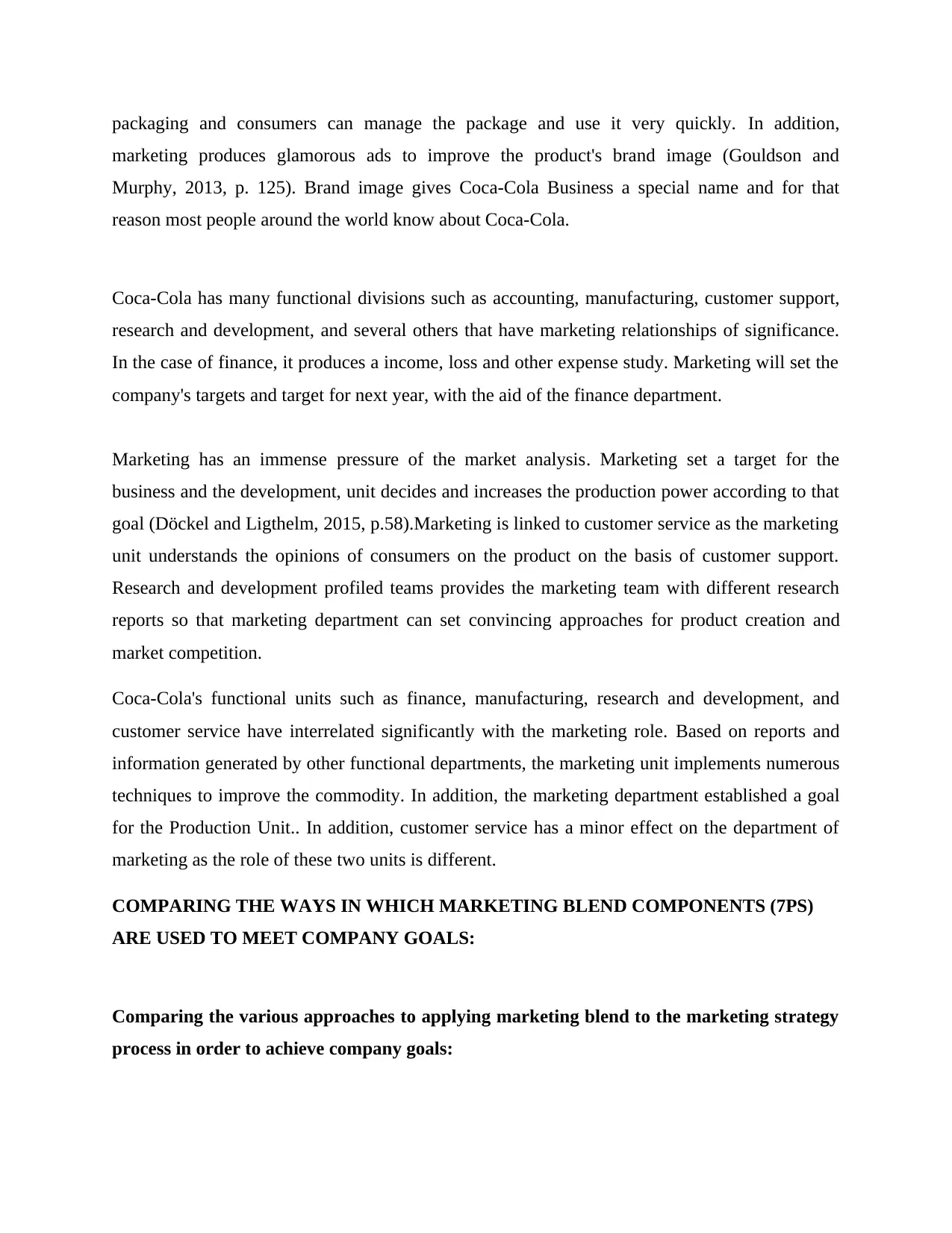
packaging and consumers can manage the package and use it very quickly. In addition,
marketing produces glamorous ads to improve the product's brand image (Gouldson and
Murphy, 2013, p. 125). Brand image gives Coca-Cola Business a special name and for that
reason most people around the world know about Coca-Cola.
Coca-Cola has many functional divisions such as accounting, manufacturing, customer support,
research and development, and several others that have marketing relationships of significance.
In the case of finance, it produces a income, loss and other expense study. Marketing will set the
company's targets and target for next year, with the aid of the finance department.
Marketing has an immense pressure of the market analysis. Marketing set a target for the
business and the development, unit decides and increases the production power according to that
goal (Döckel and Ligthelm, 2015, p.58).Marketing is linked to customer service as the marketing
unit understands the opinions of consumers on the product on the basis of customer support.
Research and development profiled teams provides the marketing team with different research
reports so that marketing department can set convincing approaches for product creation and
market competition.
Coca-Cola's functional units such as finance, manufacturing, research and development, and
customer service have interrelated significantly with the marketing role. Based on reports and
information generated by other functional departments, the marketing unit implements numerous
techniques to improve the commodity. In addition, the marketing department established a goal
for the Production Unit.. In addition, customer service has a minor effect on the department of
marketing as the role of these two units is different.
COMPARING THE WAYS IN WHICH MARKETING BLEND COMPONENTS (7PS)
ARE USED TO MEET COMPANY GOALS:
Comparing the various approaches to applying marketing blend to the marketing strategy
process in order to achieve company goals:
marketing produces glamorous ads to improve the product's brand image (Gouldson and
Murphy, 2013, p. 125). Brand image gives Coca-Cola Business a special name and for that
reason most people around the world know about Coca-Cola.
Coca-Cola has many functional divisions such as accounting, manufacturing, customer support,
research and development, and several others that have marketing relationships of significance.
In the case of finance, it produces a income, loss and other expense study. Marketing will set the
company's targets and target for next year, with the aid of the finance department.
Marketing has an immense pressure of the market analysis. Marketing set a target for the
business and the development, unit decides and increases the production power according to that
goal (Döckel and Ligthelm, 2015, p.58).Marketing is linked to customer service as the marketing
unit understands the opinions of consumers on the product on the basis of customer support.
Research and development profiled teams provides the marketing team with different research
reports so that marketing department can set convincing approaches for product creation and
market competition.
Coca-Cola's functional units such as finance, manufacturing, research and development, and
customer service have interrelated significantly with the marketing role. Based on reports and
information generated by other functional departments, the marketing unit implements numerous
techniques to improve the commodity. In addition, the marketing department established a goal
for the Production Unit.. In addition, customer service has a minor effect on the department of
marketing as the role of these two units is different.
COMPARING THE WAYS IN WHICH MARKETING BLEND COMPONENTS (7PS)
ARE USED TO MEET COMPANY GOALS:
Comparing the various approaches to applying marketing blend to the marketing strategy
process in order to achieve company goals:
Secure Best Marks with AI Grader
Need help grading? Try our AI Grader for instant feedback on your assignments.
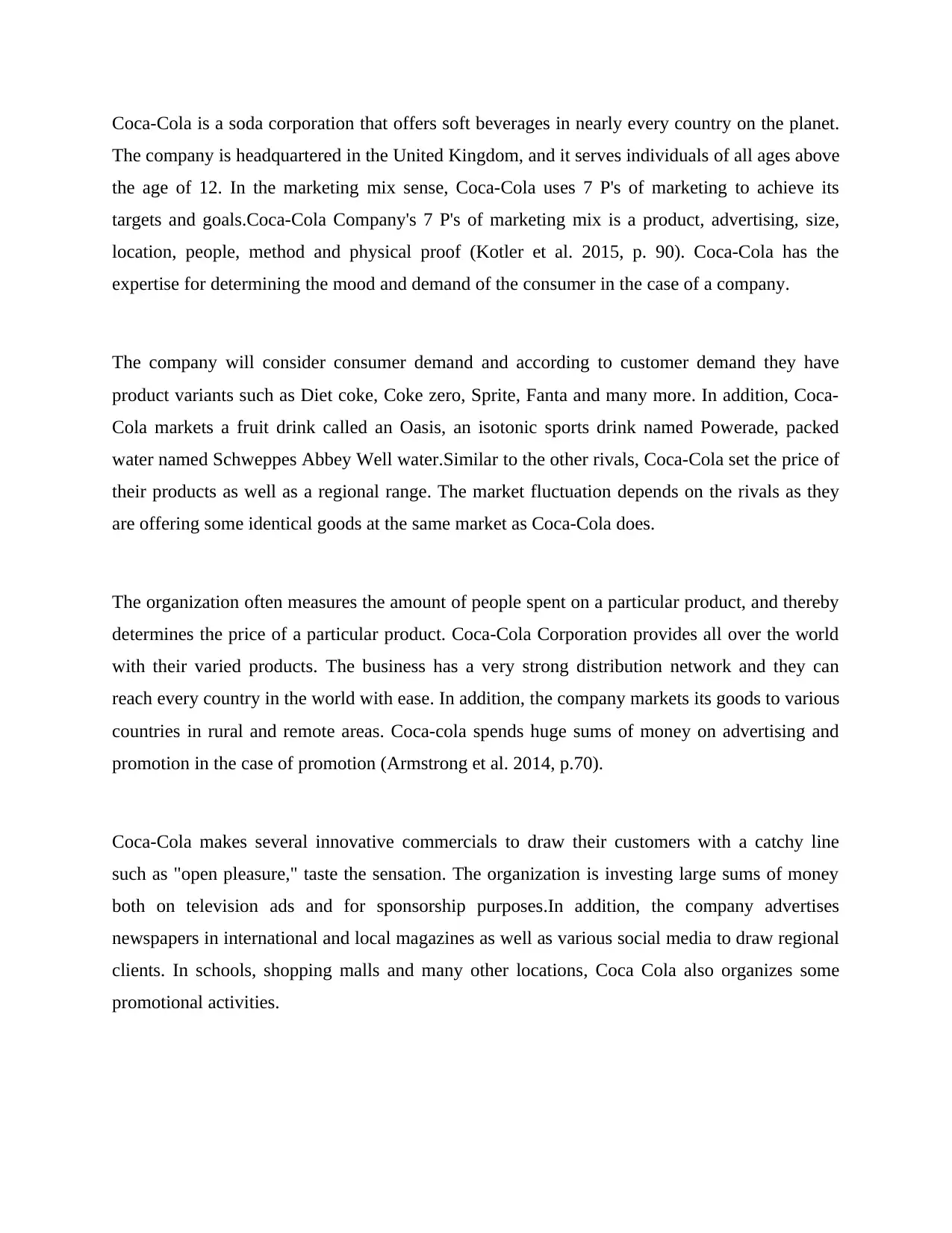
Coca-Cola is a soda corporation that offers soft beverages in nearly every country on the planet.
The company is headquartered in the United Kingdom, and it serves individuals of all ages above
the age of 12. In the marketing mix sense, Coca-Cola uses 7 P's of marketing to achieve its
targets and goals.Coca-Cola Company's 7 P's of marketing mix is a product, advertising, size,
location, people, method and physical proof (Kotler et al. 2015, p. 90). Coca-Cola has the
expertise for determining the mood and demand of the consumer in the case of a company.
The company will consider consumer demand and according to customer demand they have
product variants such as Diet coke, Coke zero, Sprite, Fanta and many more. In addition, Coca-
Cola markets a fruit drink called an Oasis, an isotonic sports drink named Powerade, packed
water named Schweppes Abbey Well water.Similar to the other rivals, Coca-Cola set the price of
their products as well as a regional range. The market fluctuation depends on the rivals as they
are offering some identical goods at the same market as Coca-Cola does.
The organization often measures the amount of people spent on a particular product, and thereby
determines the price of a particular product. Coca-Cola Corporation provides all over the world
with their varied products. The business has a very strong distribution network and they can
reach every country in the world with ease. In addition, the company markets its goods to various
countries in rural and remote areas. Coca-cola spends huge sums of money on advertising and
promotion in the case of promotion (Armstrong et al. 2014, p.70).
Coca-Cola makes several innovative commercials to draw their customers with a catchy line
such as "open pleasure," taste the sensation. The organization is investing large sums of money
both on television ads and for sponsorship purposes.In addition, the company advertises
newspapers in international and local magazines as well as various social media to draw regional
clients. In schools, shopping malls and many other locations, Coca Cola also organizes some
promotional activities.
The company is headquartered in the United Kingdom, and it serves individuals of all ages above
the age of 12. In the marketing mix sense, Coca-Cola uses 7 P's of marketing to achieve its
targets and goals.Coca-Cola Company's 7 P's of marketing mix is a product, advertising, size,
location, people, method and physical proof (Kotler et al. 2015, p. 90). Coca-Cola has the
expertise for determining the mood and demand of the consumer in the case of a company.
The company will consider consumer demand and according to customer demand they have
product variants such as Diet coke, Coke zero, Sprite, Fanta and many more. In addition, Coca-
Cola markets a fruit drink called an Oasis, an isotonic sports drink named Powerade, packed
water named Schweppes Abbey Well water.Similar to the other rivals, Coca-Cola set the price of
their products as well as a regional range. The market fluctuation depends on the rivals as they
are offering some identical goods at the same market as Coca-Cola does.
The organization often measures the amount of people spent on a particular product, and thereby
determines the price of a particular product. Coca-Cola Corporation provides all over the world
with their varied products. The business has a very strong distribution network and they can
reach every country in the world with ease. In addition, the company markets its goods to various
countries in rural and remote areas. Coca-cola spends huge sums of money on advertising and
promotion in the case of promotion (Armstrong et al. 2014, p.70).
Coca-Cola makes several innovative commercials to draw their customers with a catchy line
such as "open pleasure," taste the sensation. The organization is investing large sums of money
both on television ads and for sponsorship purposes.In addition, the company advertises
newspapers in international and local magazines as well as various social media to draw regional
clients. In schools, shopping malls and many other locations, Coca Cola also organizes some
promotional activities.
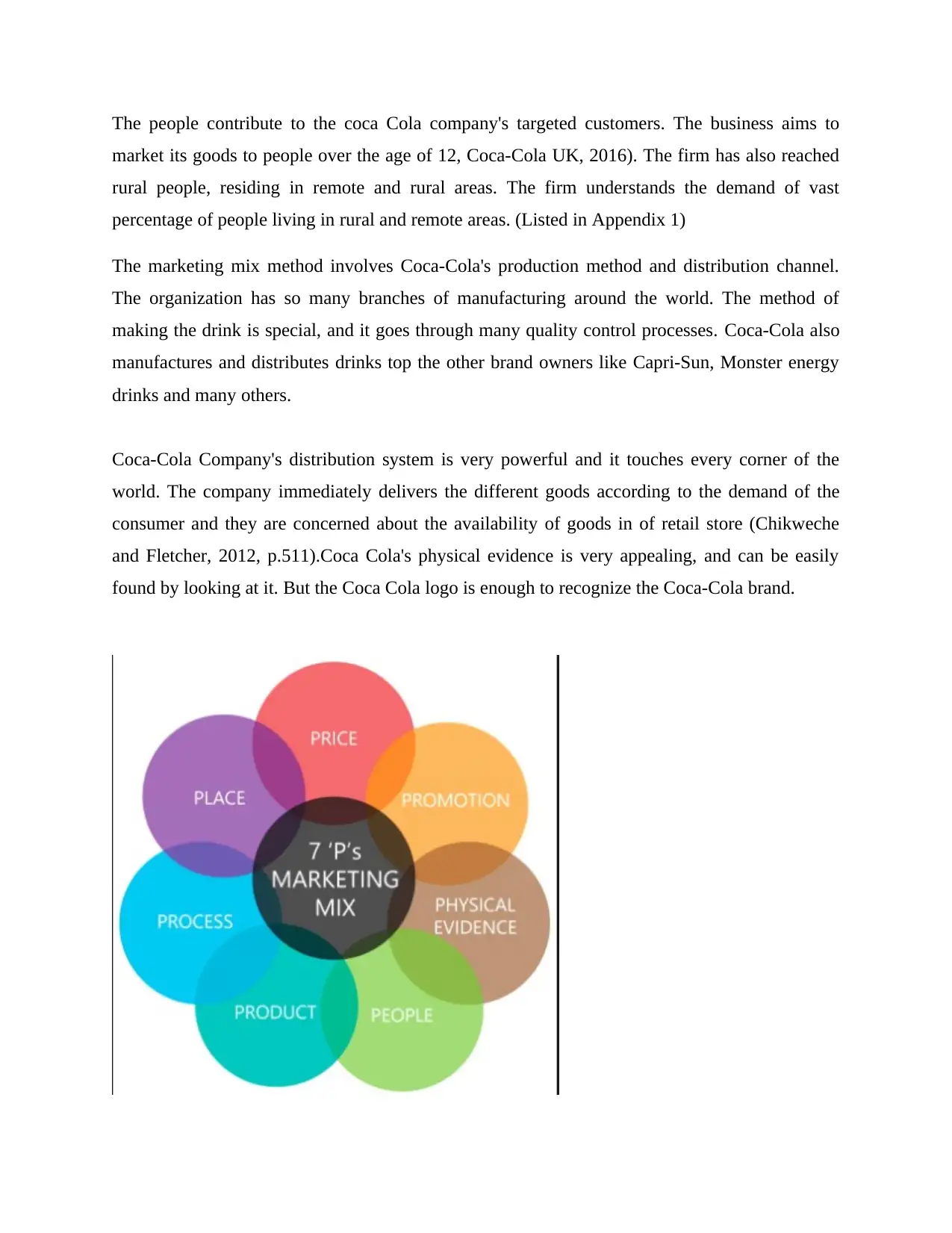
The people contribute to the coca Cola company's targeted customers. The business aims to
market its goods to people over the age of 12, Coca-Cola UK, 2016). The firm has also reached
rural people, residing in remote and rural areas. The firm understands the demand of vast
percentage of people living in rural and remote areas. (Listed in Appendix 1)
The marketing mix method involves Coca-Cola's production method and distribution channel.
The organization has so many branches of manufacturing around the world. The method of
making the drink is special, and it goes through many quality control processes. Coca-Cola also
manufactures and distributes drinks top the other brand owners like Capri-Sun, Monster energy
drinks and many others.
Coca-Cola Company's distribution system is very powerful and it touches every corner of the
world. The company immediately delivers the different goods according to the demand of the
consumer and they are concerned about the availability of goods in of retail store (Chikweche
and Fletcher, 2012, p.511).Coca Cola's physical evidence is very appealing, and can be easily
found by looking at it. But the Coca Cola logo is enough to recognize the Coca-Cola brand.
market its goods to people over the age of 12, Coca-Cola UK, 2016). The firm has also reached
rural people, residing in remote and rural areas. The firm understands the demand of vast
percentage of people living in rural and remote areas. (Listed in Appendix 1)
The marketing mix method involves Coca-Cola's production method and distribution channel.
The organization has so many branches of manufacturing around the world. The method of
making the drink is special, and it goes through many quality control processes. Coca-Cola also
manufactures and distributes drinks top the other brand owners like Capri-Sun, Monster energy
drinks and many others.
Coca-Cola Company's distribution system is very powerful and it touches every corner of the
world. The company immediately delivers the different goods according to the demand of the
consumer and they are concerned about the availability of goods in of retail store (Chikweche
and Fletcher, 2012, p.511).Coca Cola's physical evidence is very appealing, and can be easily
found by looking at it. But the Coca Cola logo is enough to recognize the Coca-Cola brand.
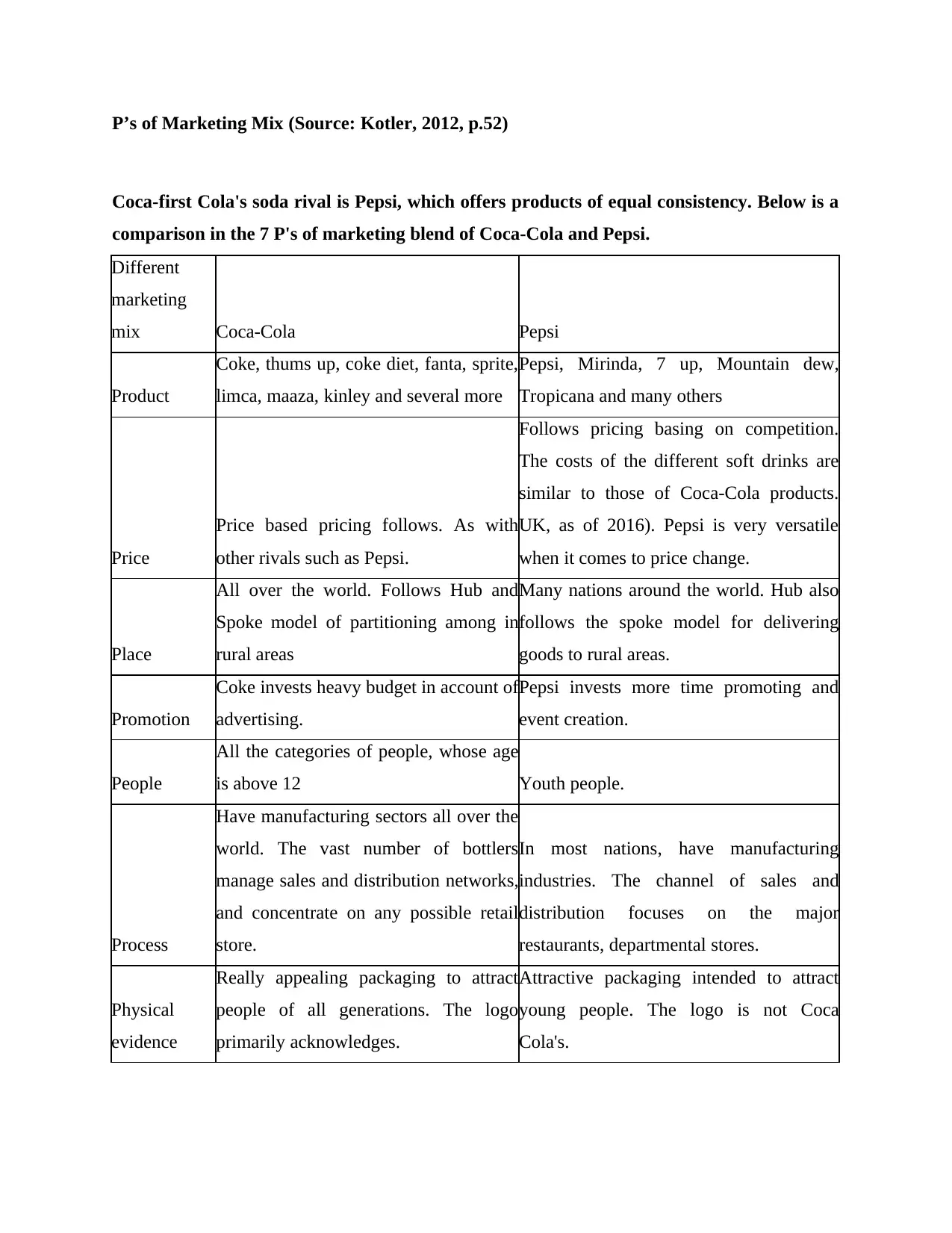
P’s of Marketing Mix (Source: Kotler, 2012, p.52)
Coca-first Cola's soda rival is Pepsi, which offers products of equal consistency. Below is a
comparison in the 7 P's of marketing blend of Coca-Cola and Pepsi.
Different
marketing
mix Coca-Cola Pepsi
Product
Coke, thums up, coke diet, fanta, sprite,
limca, maaza, kinley and several more
Pepsi, Mirinda, 7 up, Mountain dew,
Tropicana and many others
Price
Price based pricing follows. As with
other rivals such as Pepsi.
Follows pricing basing on competition.
The costs of the different soft drinks are
similar to those of Coca-Cola products.
UK, as of 2016). Pepsi is very versatile
when it comes to price change.
Place
All over the world. Follows Hub and
Spoke model of partitioning among in
rural areas
Many nations around the world. Hub also
follows the spoke model for delivering
goods to rural areas.
Promotion
Coke invests heavy budget in account of
advertising.
Pepsi invests more time promoting and
event creation.
People
All the categories of people, whose age
is above 12 Youth people.
Process
Have manufacturing sectors all over the
world. The vast number of bottlers
manage sales and distribution networks,
and concentrate on any possible retail
store.
In most nations, have manufacturing
industries. The channel of sales and
distribution focuses on the major
restaurants, departmental stores.
Physical
evidence
Really appealing packaging to attract
people of all generations. The logo
primarily acknowledges.
Attractive packaging intended to attract
young people. The logo is not Coca
Cola's.
Coca-first Cola's soda rival is Pepsi, which offers products of equal consistency. Below is a
comparison in the 7 P's of marketing blend of Coca-Cola and Pepsi.
Different
marketing
mix Coca-Cola Pepsi
Product
Coke, thums up, coke diet, fanta, sprite,
limca, maaza, kinley and several more
Pepsi, Mirinda, 7 up, Mountain dew,
Tropicana and many others
Price
Price based pricing follows. As with
other rivals such as Pepsi.
Follows pricing basing on competition.
The costs of the different soft drinks are
similar to those of Coca-Cola products.
UK, as of 2016). Pepsi is very versatile
when it comes to price change.
Place
All over the world. Follows Hub and
Spoke model of partitioning among in
rural areas
Many nations around the world. Hub also
follows the spoke model for delivering
goods to rural areas.
Promotion
Coke invests heavy budget in account of
advertising.
Pepsi invests more time promoting and
event creation.
People
All the categories of people, whose age
is above 12 Youth people.
Process
Have manufacturing sectors all over the
world. The vast number of bottlers
manage sales and distribution networks,
and concentrate on any possible retail
store.
In most nations, have manufacturing
industries. The channel of sales and
distribution focuses on the major
restaurants, departmental stores.
Physical
evidence
Really appealing packaging to attract
people of all generations. The logo
primarily acknowledges.
Attractive packaging intended to attract
young people. The logo is not Coca
Cola's.
Paraphrase This Document
Need a fresh take? Get an instant paraphrase of this document with our AI Paraphraser
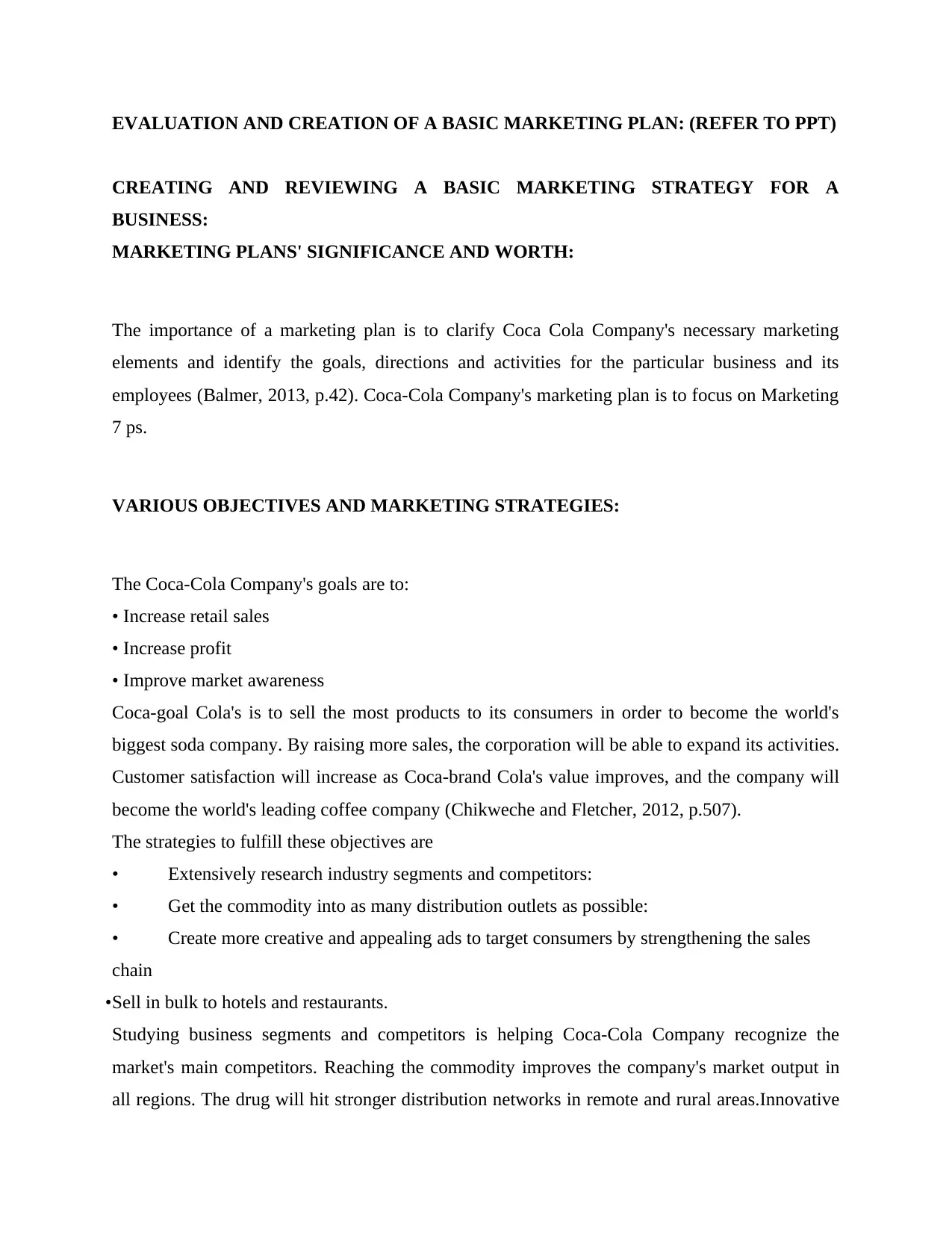
EVALUATION AND CREATION OF A BASIC MARKETING PLAN: (REFER TO PPT)
CREATING AND REVIEWING A BASIC MARKETING STRATEGY FOR A
BUSINESS:
MARKETING PLANS' SIGNIFICANCE AND WORTH:
The importance of a marketing plan is to clarify Coca Cola Company's necessary marketing
elements and identify the goals, directions and activities for the particular business and its
employees (Balmer, 2013, p.42). Coca-Cola Company's marketing plan is to focus on Marketing
7 ps.
VARIOUS OBJECTIVES AND MARKETING STRATEGIES:
The Coca-Cola Company's goals are to:
• Increase retail sales
• Increase profit
• Improve market awareness
Coca-goal Cola's is to sell the most products to its consumers in order to become the world's
biggest soda company. By raising more sales, the corporation will be able to expand its activities.
Customer satisfaction will increase as Coca-brand Cola's value improves, and the company will
become the world's leading coffee company (Chikweche and Fletcher, 2012, p.507).
The strategies to fulfill these objectives are
• Extensively research industry segments and competitors:
• Get the commodity into as many distribution outlets as possible:
• Create more creative and appealing ads to target consumers by strengthening the sales
chain
•Sell in bulk to hotels and restaurants.
Studying business segments and competitors is helping Coca-Cola Company recognize the
market's main competitors. Reaching the commodity improves the company's market output in
all regions. The drug will hit stronger distribution networks in remote and rural areas.Innovative
CREATING AND REVIEWING A BASIC MARKETING STRATEGY FOR A
BUSINESS:
MARKETING PLANS' SIGNIFICANCE AND WORTH:
The importance of a marketing plan is to clarify Coca Cola Company's necessary marketing
elements and identify the goals, directions and activities for the particular business and its
employees (Balmer, 2013, p.42). Coca-Cola Company's marketing plan is to focus on Marketing
7 ps.
VARIOUS OBJECTIVES AND MARKETING STRATEGIES:
The Coca-Cola Company's goals are to:
• Increase retail sales
• Increase profit
• Improve market awareness
Coca-goal Cola's is to sell the most products to its consumers in order to become the world's
biggest soda company. By raising more sales, the corporation will be able to expand its activities.
Customer satisfaction will increase as Coca-brand Cola's value improves, and the company will
become the world's leading coffee company (Chikweche and Fletcher, 2012, p.507).
The strategies to fulfill these objectives are
• Extensively research industry segments and competitors:
• Get the commodity into as many distribution outlets as possible:
• Create more creative and appealing ads to target consumers by strengthening the sales
chain
•Sell in bulk to hotels and restaurants.
Studying business segments and competitors is helping Coca-Cola Company recognize the
market's main competitors. Reaching the commodity improves the company's market output in
all regions. The drug will hit stronger distribution networks in remote and rural areas.Innovative
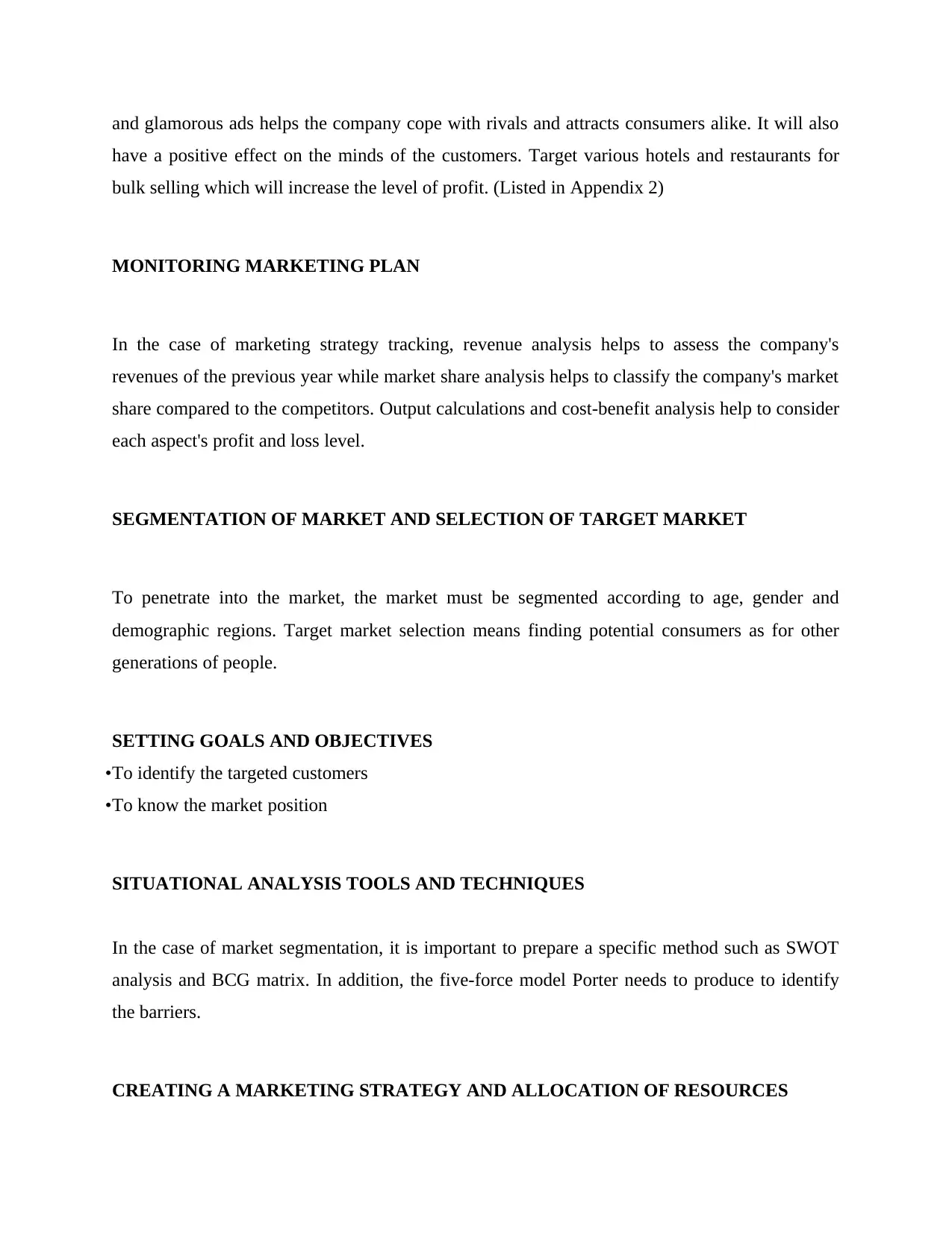
and glamorous ads helps the company cope with rivals and attracts consumers alike. It will also
have a positive effect on the minds of the customers. Target various hotels and restaurants for
bulk selling which will increase the level of profit. (Listed in Appendix 2)
MONITORING MARKETING PLAN
In the case of marketing strategy tracking, revenue analysis helps to assess the company's
revenues of the previous year while market share analysis helps to classify the company's market
share compared to the competitors. Output calculations and cost-benefit analysis help to consider
each aspect's profit and loss level.
SEGMENTATION OF MARKET AND SELECTION OF TARGET MARKET
To penetrate into the market, the market must be segmented according to age, gender and
demographic regions. Target market selection means finding potential consumers as for other
generations of people.
SETTING GOALS AND OBJECTIVES
•To identify the targeted customers
•To know the market position
SITUATIONAL ANALYSIS TOOLS AND TECHNIQUES
In the case of market segmentation, it is important to prepare a specific method such as SWOT
analysis and BCG matrix. In addition, the five-force model Porter needs to produce to identify
the barriers.
CREATING A MARKETING STRATEGY AND ALLOCATION OF RESOURCES
have a positive effect on the minds of the customers. Target various hotels and restaurants for
bulk selling which will increase the level of profit. (Listed in Appendix 2)
MONITORING MARKETING PLAN
In the case of marketing strategy tracking, revenue analysis helps to assess the company's
revenues of the previous year while market share analysis helps to classify the company's market
share compared to the competitors. Output calculations and cost-benefit analysis help to consider
each aspect's profit and loss level.
SEGMENTATION OF MARKET AND SELECTION OF TARGET MARKET
To penetrate into the market, the market must be segmented according to age, gender and
demographic regions. Target market selection means finding potential consumers as for other
generations of people.
SETTING GOALS AND OBJECTIVES
•To identify the targeted customers
•To know the market position
SITUATIONAL ANALYSIS TOOLS AND TECHNIQUES
In the case of market segmentation, it is important to prepare a specific method such as SWOT
analysis and BCG matrix. In addition, the five-force model Porter needs to produce to identify
the barriers.
CREATING A MARKETING STRATEGY AND ALLOCATION OF RESOURCES
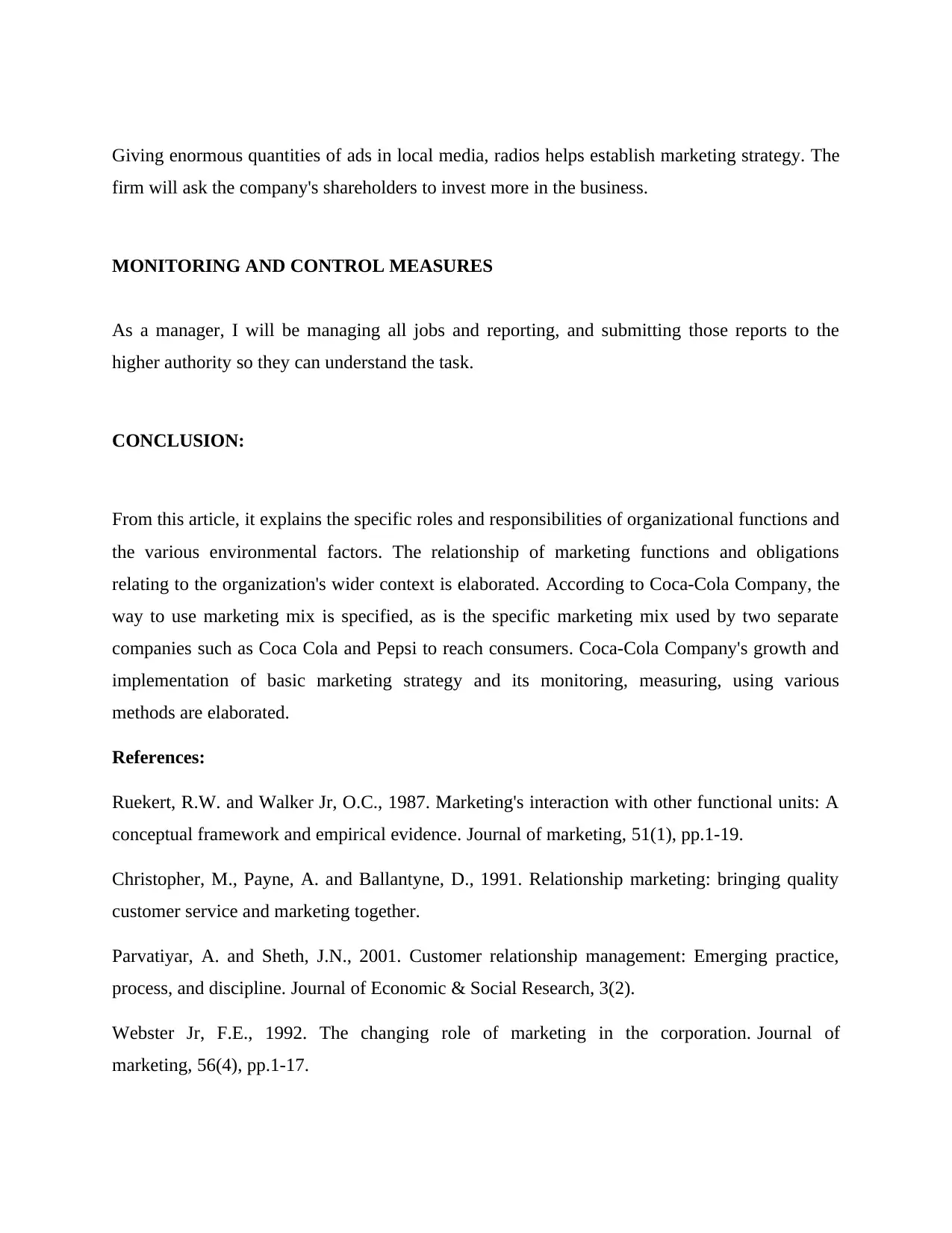
Giving enormous quantities of ads in local media, radios helps establish marketing strategy. The
firm will ask the company's shareholders to invest more in the business.
MONITORING AND CONTROL MEASURES
As a manager, I will be managing all jobs and reporting, and submitting those reports to the
higher authority so they can understand the task.
CONCLUSION:
From this article, it explains the specific roles and responsibilities of organizational functions and
the various environmental factors. The relationship of marketing functions and obligations
relating to the organization's wider context is elaborated. According to Coca-Cola Company, the
way to use marketing mix is specified, as is the specific marketing mix used by two separate
companies such as Coca Cola and Pepsi to reach consumers. Coca-Cola Company's growth and
implementation of basic marketing strategy and its monitoring, measuring, using various
methods are elaborated.
References:
Ruekert, R.W. and Walker Jr, O.C., 1987. Marketing's interaction with other functional units: A
conceptual framework and empirical evidence. Journal of marketing, 51(1), pp.1-19.
Christopher, M., Payne, A. and Ballantyne, D., 1991. Relationship marketing: bringing quality
customer service and marketing together.
Parvatiyar, A. and Sheth, J.N., 2001. Customer relationship management: Emerging practice,
process, and discipline. Journal of Economic & Social Research, 3(2).
Webster Jr, F.E., 1992. The changing role of marketing in the corporation. Journal of
marketing, 56(4), pp.1-17.
firm will ask the company's shareholders to invest more in the business.
MONITORING AND CONTROL MEASURES
As a manager, I will be managing all jobs and reporting, and submitting those reports to the
higher authority so they can understand the task.
CONCLUSION:
From this article, it explains the specific roles and responsibilities of organizational functions and
the various environmental factors. The relationship of marketing functions and obligations
relating to the organization's wider context is elaborated. According to Coca-Cola Company, the
way to use marketing mix is specified, as is the specific marketing mix used by two separate
companies such as Coca Cola and Pepsi to reach consumers. Coca-Cola Company's growth and
implementation of basic marketing strategy and its monitoring, measuring, using various
methods are elaborated.
References:
Ruekert, R.W. and Walker Jr, O.C., 1987. Marketing's interaction with other functional units: A
conceptual framework and empirical evidence. Journal of marketing, 51(1), pp.1-19.
Christopher, M., Payne, A. and Ballantyne, D., 1991. Relationship marketing: bringing quality
customer service and marketing together.
Parvatiyar, A. and Sheth, J.N., 2001. Customer relationship management: Emerging practice,
process, and discipline. Journal of Economic & Social Research, 3(2).
Webster Jr, F.E., 1992. The changing role of marketing in the corporation. Journal of
marketing, 56(4), pp.1-17.
Secure Best Marks with AI Grader
Need help grading? Try our AI Grader for instant feedback on your assignments.
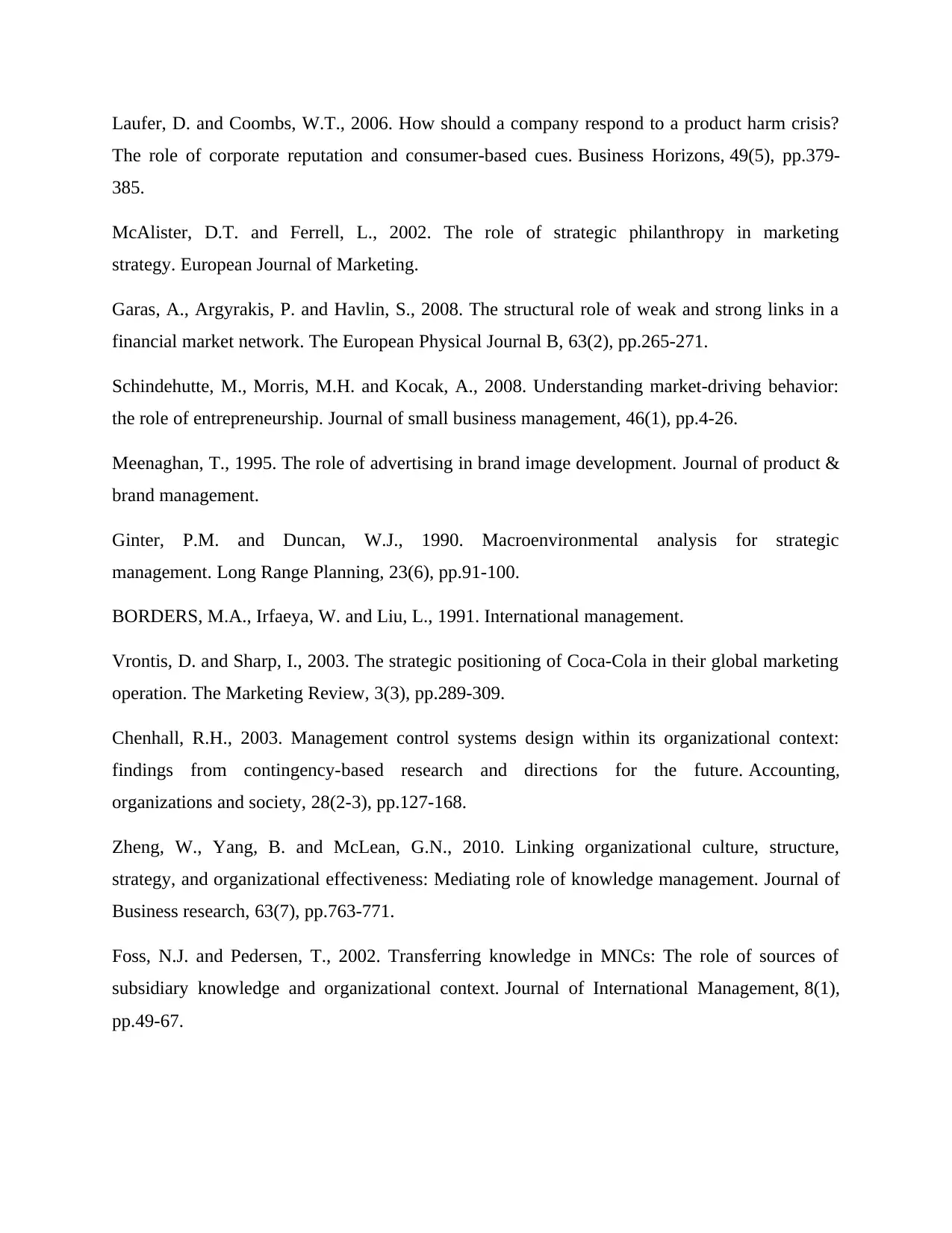
Laufer, D. and Coombs, W.T., 2006. How should a company respond to a product harm crisis?
The role of corporate reputation and consumer-based cues. Business Horizons, 49(5), pp.379-
385.
McAlister, D.T. and Ferrell, L., 2002. The role of strategic philanthropy in marketing
strategy. European Journal of Marketing.
Garas, A., Argyrakis, P. and Havlin, S., 2008. The structural role of weak and strong links in a
financial market network. The European Physical Journal B, 63(2), pp.265-271.
Schindehutte, M., Morris, M.H. and Kocak, A., 2008. Understanding market‐driving behavior:
the role of entrepreneurship. Journal of small business management, 46(1), pp.4-26.
Meenaghan, T., 1995. The role of advertising in brand image development. Journal of product &
brand management.
Ginter, P.M. and Duncan, W.J., 1990. Macroenvironmental analysis for strategic
management. Long Range Planning, 23(6), pp.91-100.
BORDERS, M.A., Irfaeya, W. and Liu, L., 1991. International management.
Vrontis, D. and Sharp, I., 2003. The strategic positioning of Coca-Cola in their global marketing
operation. The Marketing Review, 3(3), pp.289-309.
Chenhall, R.H., 2003. Management control systems design within its organizational context:
findings from contingency-based research and directions for the future. Accounting,
organizations and society, 28(2-3), pp.127-168.
Zheng, W., Yang, B. and McLean, G.N., 2010. Linking organizational culture, structure,
strategy, and organizational effectiveness: Mediating role of knowledge management. Journal of
Business research, 63(7), pp.763-771.
Foss, N.J. and Pedersen, T., 2002. Transferring knowledge in MNCs: The role of sources of
subsidiary knowledge and organizational context. Journal of International Management, 8(1),
pp.49-67.
The role of corporate reputation and consumer-based cues. Business Horizons, 49(5), pp.379-
385.
McAlister, D.T. and Ferrell, L., 2002. The role of strategic philanthropy in marketing
strategy. European Journal of Marketing.
Garas, A., Argyrakis, P. and Havlin, S., 2008. The structural role of weak and strong links in a
financial market network. The European Physical Journal B, 63(2), pp.265-271.
Schindehutte, M., Morris, M.H. and Kocak, A., 2008. Understanding market‐driving behavior:
the role of entrepreneurship. Journal of small business management, 46(1), pp.4-26.
Meenaghan, T., 1995. The role of advertising in brand image development. Journal of product &
brand management.
Ginter, P.M. and Duncan, W.J., 1990. Macroenvironmental analysis for strategic
management. Long Range Planning, 23(6), pp.91-100.
BORDERS, M.A., Irfaeya, W. and Liu, L., 1991. International management.
Vrontis, D. and Sharp, I., 2003. The strategic positioning of Coca-Cola in their global marketing
operation. The Marketing Review, 3(3), pp.289-309.
Chenhall, R.H., 2003. Management control systems design within its organizational context:
findings from contingency-based research and directions for the future. Accounting,
organizations and society, 28(2-3), pp.127-168.
Zheng, W., Yang, B. and McLean, G.N., 2010. Linking organizational culture, structure,
strategy, and organizational effectiveness: Mediating role of knowledge management. Journal of
Business research, 63(7), pp.763-771.
Foss, N.J. and Pedersen, T., 2002. Transferring knowledge in MNCs: The role of sources of
subsidiary knowledge and organizational context. Journal of International Management, 8(1),
pp.49-67.
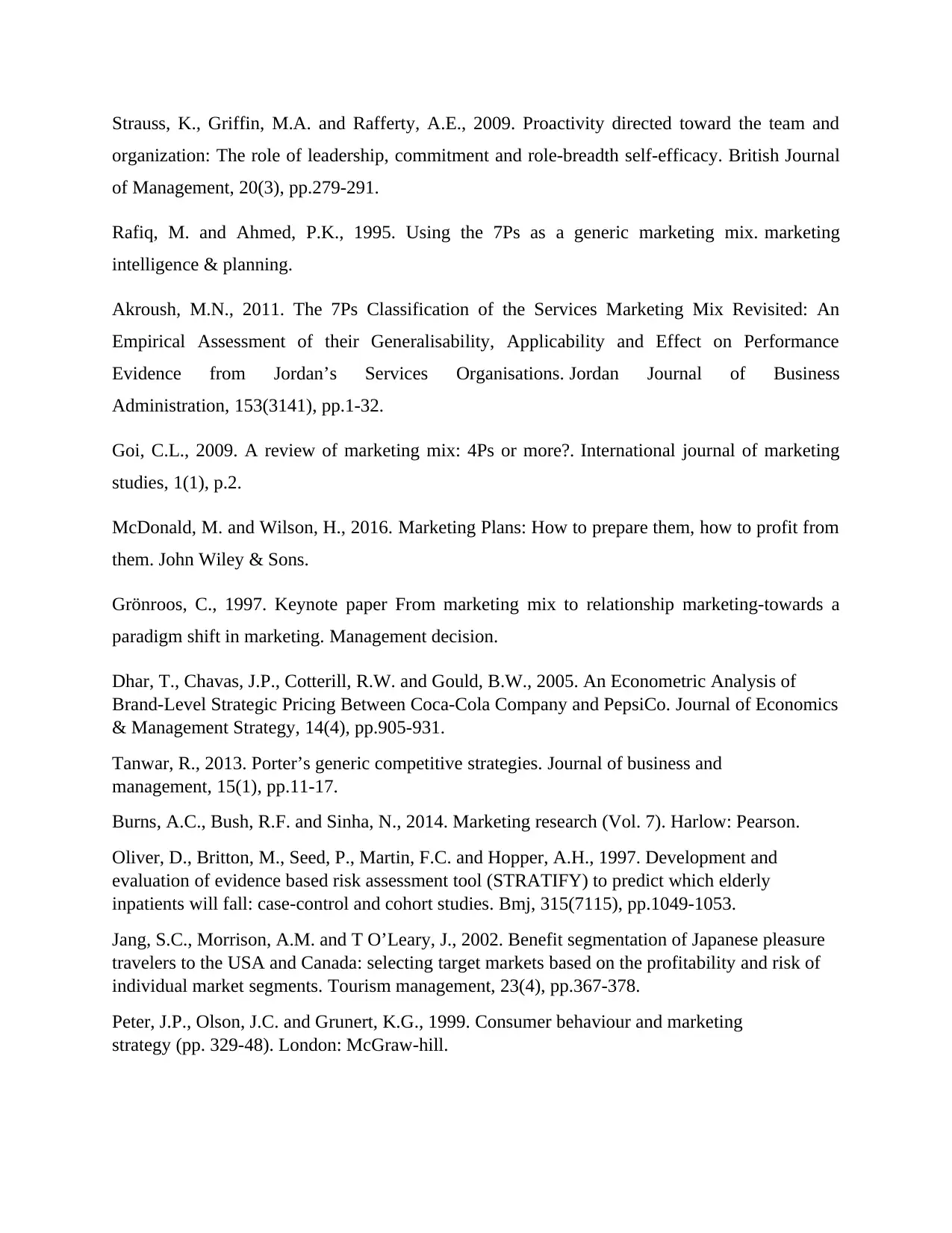
Strauss, K., Griffin, M.A. and Rafferty, A.E., 2009. Proactivity directed toward the team and
organization: The role of leadership, commitment and role‐breadth self‐efficacy. British Journal
of Management, 20(3), pp.279-291.
Rafiq, M. and Ahmed, P.K., 1995. Using the 7Ps as a generic marketing mix. marketing
intelligence & planning.
Akroush, M.N., 2011. The 7Ps Classification of the Services Marketing Mix Revisited: An
Empirical Assessment of their Generalisability, Applicability and Effect on Performance
Evidence from Jordan’s Services Organisations. Jordan Journal of Business
Administration, 153(3141), pp.1-32.
Goi, C.L., 2009. A review of marketing mix: 4Ps or more?. International journal of marketing
studies, 1(1), p.2.
McDonald, M. and Wilson, H., 2016. Marketing Plans: How to prepare them, how to profit from
them. John Wiley & Sons.
Grönroos, C., 1997. Keynote paper From marketing mix to relationship marketing‐towards a
paradigm shift in marketing. Management decision.
Dhar, T., Chavas, J.P., Cotterill, R.W. and Gould, B.W., 2005. An Econometric Analysis of
Brand‐Level Strategic Pricing Between Coca‐Cola Company and PepsiCo. Journal of Economics
& Management Strategy, 14(4), pp.905-931.
Tanwar, R., 2013. Porter’s generic competitive strategies. Journal of business and
management, 15(1), pp.11-17.
Burns, A.C., Bush, R.F. and Sinha, N., 2014. Marketing research (Vol. 7). Harlow: Pearson.
Oliver, D., Britton, M., Seed, P., Martin, F.C. and Hopper, A.H., 1997. Development and
evaluation of evidence based risk assessment tool (STRATIFY) to predict which elderly
inpatients will fall: case-control and cohort studies. Bmj, 315(7115), pp.1049-1053.
Jang, S.C., Morrison, A.M. and T O’Leary, J., 2002. Benefit segmentation of Japanese pleasure
travelers to the USA and Canada: selecting target markets based on the profitability and risk of
individual market segments. Tourism management, 23(4), pp.367-378.
Peter, J.P., Olson, J.C. and Grunert, K.G., 1999. Consumer behaviour and marketing
strategy (pp. 329-48). London: McGraw-hill.
organization: The role of leadership, commitment and role‐breadth self‐efficacy. British Journal
of Management, 20(3), pp.279-291.
Rafiq, M. and Ahmed, P.K., 1995. Using the 7Ps as a generic marketing mix. marketing
intelligence & planning.
Akroush, M.N., 2011. The 7Ps Classification of the Services Marketing Mix Revisited: An
Empirical Assessment of their Generalisability, Applicability and Effect on Performance
Evidence from Jordan’s Services Organisations. Jordan Journal of Business
Administration, 153(3141), pp.1-32.
Goi, C.L., 2009. A review of marketing mix: 4Ps or more?. International journal of marketing
studies, 1(1), p.2.
McDonald, M. and Wilson, H., 2016. Marketing Plans: How to prepare them, how to profit from
them. John Wiley & Sons.
Grönroos, C., 1997. Keynote paper From marketing mix to relationship marketing‐towards a
paradigm shift in marketing. Management decision.
Dhar, T., Chavas, J.P., Cotterill, R.W. and Gould, B.W., 2005. An Econometric Analysis of
Brand‐Level Strategic Pricing Between Coca‐Cola Company and PepsiCo. Journal of Economics
& Management Strategy, 14(4), pp.905-931.
Tanwar, R., 2013. Porter’s generic competitive strategies. Journal of business and
management, 15(1), pp.11-17.
Burns, A.C., Bush, R.F. and Sinha, N., 2014. Marketing research (Vol. 7). Harlow: Pearson.
Oliver, D., Britton, M., Seed, P., Martin, F.C. and Hopper, A.H., 1997. Development and
evaluation of evidence based risk assessment tool (STRATIFY) to predict which elderly
inpatients will fall: case-control and cohort studies. Bmj, 315(7115), pp.1049-1053.
Jang, S.C., Morrison, A.M. and T O’Leary, J., 2002. Benefit segmentation of Japanese pleasure
travelers to the USA and Canada: selecting target markets based on the profitability and risk of
individual market segments. Tourism management, 23(4), pp.367-378.
Peter, J.P., Olson, J.C. and Grunert, K.G., 1999. Consumer behaviour and marketing
strategy (pp. 329-48). London: McGraw-hill.
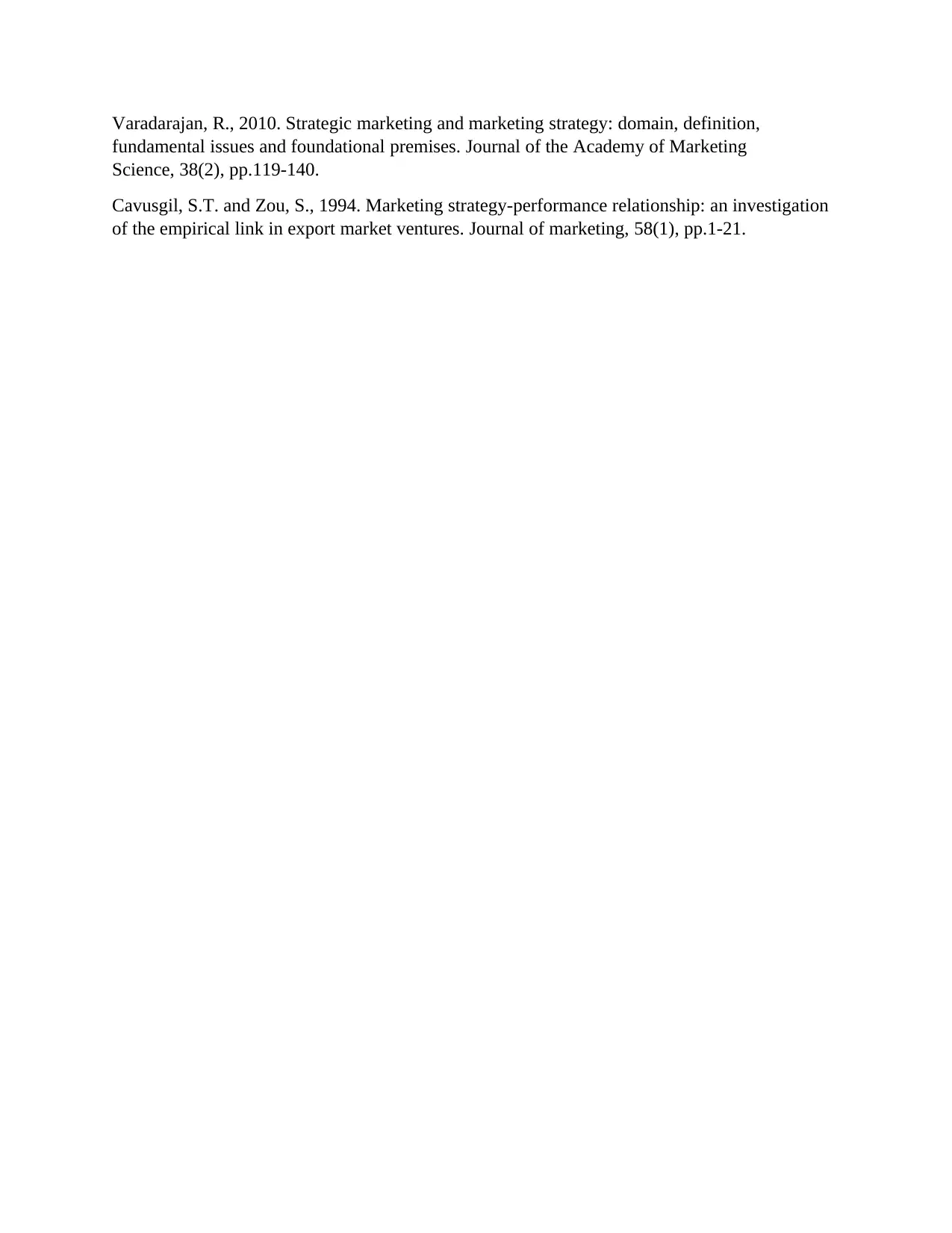
Varadarajan, R., 2010. Strategic marketing and marketing strategy: domain, definition,
fundamental issues and foundational premises. Journal of the Academy of Marketing
Science, 38(2), pp.119-140.
Cavusgil, S.T. and Zou, S., 1994. Marketing strategy-performance relationship: an investigation
of the empirical link in export market ventures. Journal of marketing, 58(1), pp.1-21.
fundamental issues and foundational premises. Journal of the Academy of Marketing
Science, 38(2), pp.119-140.
Cavusgil, S.T. and Zou, S., 1994. Marketing strategy-performance relationship: an investigation
of the empirical link in export market ventures. Journal of marketing, 58(1), pp.1-21.
1 out of 13
Related Documents
Your All-in-One AI-Powered Toolkit for Academic Success.
+13062052269
info@desklib.com
Available 24*7 on WhatsApp / Email
![[object Object]](/_next/static/media/star-bottom.7253800d.svg)
Unlock your academic potential
© 2024 | Zucol Services PVT LTD | All rights reserved.





